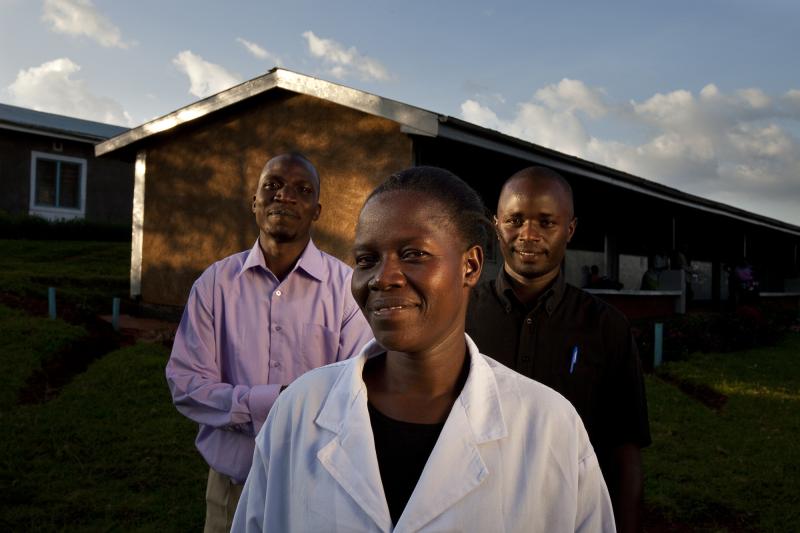Where We Work
See our interactive map


Photo by Trevor Snapp for IntraHealth International.
At last, our field is facing the facts.
Looking over the program of the Fourth Global Forum on Human Resources for Health (HRH), held in Dublin last month, it was clear how far the field has come in collectively recognizing the importance of gender equality in the health workforce.
In Dublin, some aspect of gender was central to four of the conference sessions, and a new Gender Equity Network, coordinated by the World Health Organization (WHO) and Women in Global Health, made up of research, advocacy, and implementation institutions, has already begun work on a two-year plan of action.
This is a far cry from the marginal status of gender equality at the 2013 Third Global Forum on HRH in Recife, Brazil.
Sexual harassment undermines effective health sector leadership.
The new legitimacy of gender equality in the premier global gathering of HRH professionals is a result of 20 years of concerted, evidence-based advocacy, research, and publication. We first saw these shifts in the global policy dialogue and the consensus reflected in the Sustainable Development Goals (5 and 8), the 2016 WHO Global Strategy on Human Resources for Health: Workforce 2030, and the 2016 WHO Report of the High-Level Commission on Health Employment and Economic Growth.
But I remember a time—as recently as 2014—when the findings I had submitted to a well-known peer-reviewed journal concerning patterns of gender discrimination in health education and employment settings were politely declined, on the grounds that the subject matter was “too dark.”
As I mused about possible ways to make the subject of gender discrimination and inequality less “dark,” a more intrepid journal stepped into the breach and published the results.
Our newest publication—Reasons behind Current Gender Imbalances in Senior Global Health Roles and the Practice and Policy Changes that Can Catalyze Organizational Change—continues to shed light on the role of gender discrimination, and particularly gender segregation, in abridging women’s leadership opportunities.
This publication presents evidence on the reasons for the gender imbalances in global health roles and senior representation, all of which points to embedded bias and processes of continuous gendering that reproduce societal inequalities in health workplaces, and that it is therefore necessary to target the organization itself as the main site of change. Strategies include:
As peer-reviewed journals, academics, HRH practitioners, and global conferences catch up with field research and allow more heterodox findings into the mainstream, they will reveal to HRH practitioners and policy-makers the full range of factors driving the less-than-adequate health worker pipelines, health workforce attrition, and the abridgements of women’s ability to access opportunities for leadership and participation in the health careers of their choice.
Sexual harassment is linked to resignations, punitive transfers, demotions, and more.
At IntraHealth International, we continue to be at the forefront of multimethod gender and HRH research and practice.
For instance, our multimethod formative assessment of sexual harassment in Uganda’s health sector found that supervision and district recruitment systems in Uganda’s public health sector were rife with quid pro quo sexual harassment, a form of workplace violence and gender discrimination.
Sexual harassment undermines effective health sector leadership, management, and governance, and Uganda’s Ministry of Health wants to address it. The supposed enforcers of national regulations are key perpetrators, as supervisors may use performance appraisals to settle scores for refusing sex, or may favor those who submit to demands for sexual favors. Refusal results in victimization and unfavorable work conditions.
Sexual harassment is linked to resignations, punitive transfers, staff conflict, demotions, or denial of promotion to leadership jobs for those women who refuse the sexual quid pro quo. Reporting involves a high likelihood of secondary victimization.
In response to these findings, the ministry sponsored a national dissemination meeting in early November and convened a multisectoral working group to design a pilot system for sexual harassment prevention and response to protect health workers’ safety, security, and human/ labor rights. This will be piloted in 2018.
And our 2017 gender analysis of women’s leadership in supply chain management in Ethiopia—which used surveys, key informant interviews, focus group discussion, and analysis of personnel data—documented striking vertical and horizontal segregation of the Pharmaceuticals Fund and Supply Agency’s workforce, as well as gender-related factors that contribute to women’s underparticipation in supply chain jobs in varied and senior roles. These include:
The study helped identify priority action items to address these factors and strategies to further women’s leadership.
Some may still call these study results dark. But as the academy, peer-review journals, and HRH policy-makers come to grips with gender discrimination in the health workforce, the field of human resources for health will come of age—and become more effective.
Get the latest updates from the blog and eNews




